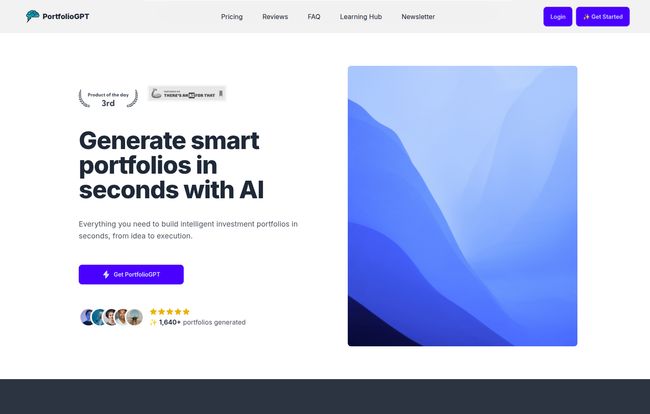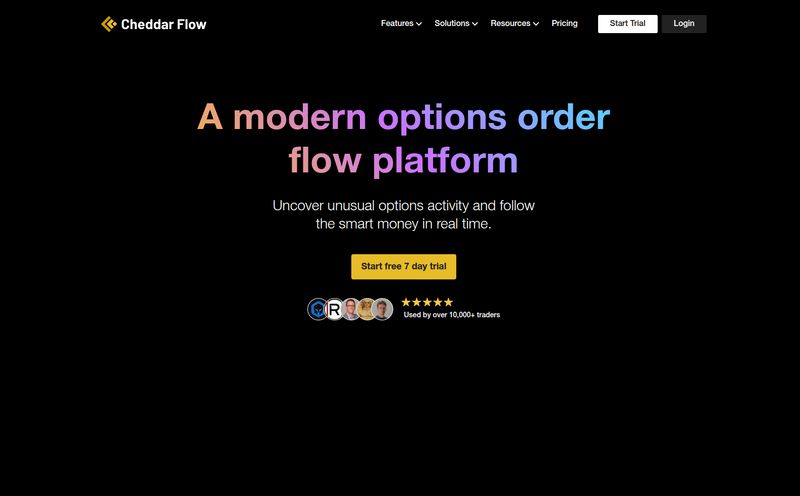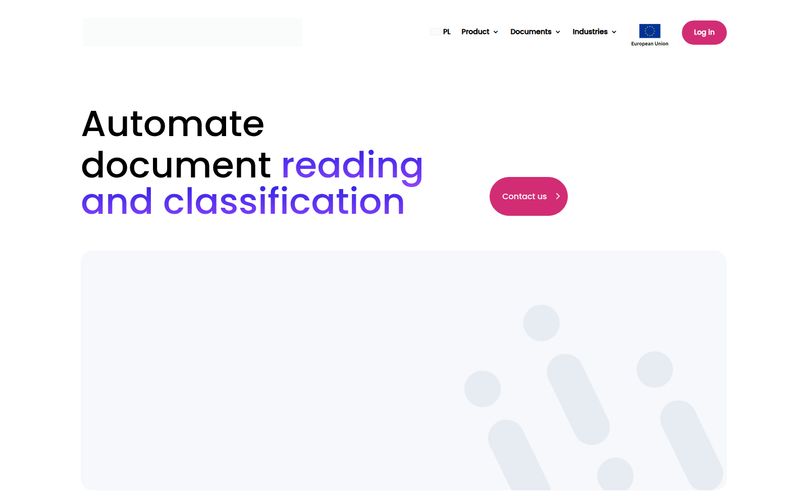I still remember the first time I decided to “get serious” about investing. I spent an entire weekend glued to my screen, drowning in a sea of browser tabs. One tab for stock screeners, another for ETF comparisons, a dozen for financial news sites, and a few more for YouTube gurus promising to make me the next Warren Buffett. By Sunday night, I had a migraine, a half-finished spreadsheet, and a portfolio I wasn't even sure I liked. Sound familiar?
We’ve all been there. The analysis paralysis is real. The financial world is a noisy, complicated place, and the fear of making a wrong move can be crippling. The landing page for a tool I stumbled upon recently, PortfolioGPT, claims that 90% of investors fail because of emotional biases and a lack of tools. I don't know about that exact number, but it feels right in my gut.
So, when I see a tool that promises to generate a smart, personalized investment portfolio in seconds using AI, my inner SEO-nerd and my frustrated-investor-self both sit up and pay attention. Is this just more tech hype, or could it genuinely change the game for DIY investors? Let's find out.
So What is This PortfolioGPT Thing Anyway?
At its core, PortfolioGPT is an AI-powered investment idea generator. You don't connect your bank account or brokerage. It’s not another robo-advisor that manages your money for you. Think of it more like a brilliant, lightning-fast financial analyst who's on call 24/7.
You feed it the basic ingredients: how much you want to invest, your age, what your financial goals are (e.g., retirement, buying a house), your investment timeframe, and—crucially—your tolerance for risk. You can even tell it which asset classes you're interested in, from plain old stocks and ETFs to real estate and crypto. It then takes this information, runs it through OpenAI's advanced algorithms (yes, the same family of tech behind ChatGPT), and spits out a tailored portfolio suggestion. Instantly.
Putting it to the Test: My First Run-Through
Okay, enough talk. I had to see it in action. I jumped onto their site, which is clean and refreshingly simple. No fluff. I decided to create a hypothetical portfolio for a 30-year-old looking to invest $10,000 for long-term growth with a moderate risk tolerance.
I plugged in the numbers, selected my preferences (a mix of stocks and ETFs), and hit the button. And… that was it. No loading spinner of doom. No waiting. A complete portfolio breakdown appeared in literally seconds. It wasn't just a list of ticker symbols; it was a diversified plan with percentage allocations for each holding and a brief rationale. It was the kind of thing that would have taken me, conservatively, an entire afternoon to research and piece together myself.

Visit PortfolioGPT
The speed is genuinely impressive. It felt less like a clunky piece of software and more like a conversation with a very, very smart machine.
The Core Features That Actually Matter
A lot of AI tools are just fancy wrappers around a simple function. But after playing around with PortfolioGPT, a few key features stood out to me as being genuinely useful.
AI-Powered Portfolio Generation (The Brains of the Operation)
This is the main event. The AI isn't just randomly picking trendy stocks. It's working on the principles of diversification and asset allocation, which are the cornerstones of sound investing. It suggests a mix of assets designed to balance risk and reward based on your specific inputs. This is a massive leap from just Googling “best stocks to buy now,” which is a recipe for disaster.
Personalized Risk Profiling (Not a One-Size-Fits-All Mess)
I can't stress this enough: understanding your own risk tolerance is probably the single most important part of investing. PortfolioGPT bakes this right into its process. A portfolio for a 22-year-old with a high-risk tolerance should look dramatically different from one for a 60-year-old nearing retirement. The platform gets this, and it prevents you from falling into a strategy that doesn’t match your stomach for market swings.
Instantaneous Suggestions (Goodbye, Analysis Paralysis)
Remember my weekend of research hell? This tool collapses that timeline from hours or days into seconds. It gives you a fully-formed, intelligent starting point. You can take its suggestion, tweak it, research its individual components further, or just use it as a sanity check against your own ideas. It breaks the inertia that stops so many people from ever starting.
So, How Much Does This AI Analyst Cost?
This is always the big question, right? I was pleasantly surprised here. The pricing is straightforward and, in my opinion, very reasonable. They have a pretty generous free plan and a couple of paid tiers for power users.
| Plan | Price | Key Features |
|---|---|---|
| Free Plan | $0 | 5 queries per day, GPT-4o mini, instant portfolios, email support. Perfect for trying it out. |
| Monthly Plan | $3 / month | Unlimited queries, uses a more advanced "Reasoning Model", priority email support. |
| Annual Plan | $27 / year | Same as Monthly, but saves you 25%. This seems like the no-brainer choice if you're going to use it regularly. |
Honestly, for less than a single cup of fancy coffee a month, getting unlimited access to a tool that can save you dozens of hours of research feels like a steal. The free plan is more than enough to see if it works for you, which I always appreciate.
Who is PortfolioGPT Really For? (And Who Should Steer Clear)
This tool isn't for everyone, and that's okay. It shines brightest for a specific type of person.
It's a fantastic fit for:
- The Overwhelmed Beginner: If you want to invest but don't know where to start, this provides an incredible launchpad.
- The DIY Investor: If you already manage your own portfolio, this is a great tool for generating new ideas or getting a second opinion on your current strategy.
- The Curious Tinkerer: Want to see what a crypto-heavy, high-risk portfolio looks like versus a conservative real-estate-focused one? You can generate dozens of scenarios in minutes. It's a great tool for gut-checking you're own ideas.
You might want to skip it if:
- You want a full-service financial advisor: This is a tool, not a human advisor who will manage your money and emotions for you.
- You're looking for a managed fund: If you just want to deposit money and have someone else handle everything, a traditional robo-advisor or index fund might be a better choice.
The Big, Bold Disclaimer: A Tool, Not a Guru
This is the most important part of this entire review. PortfolioGPT says it right on their site: this is for educational purposes and is not a substitute for professional financial advice. I couldn't agree more.
Think of it like a sophisticated GPS for your finances. A GPS can show you the fastest route to your destination, factoring in traffic and road closures. But it can't tell you if you'll actually enjoy the destination. It doesn't know if you'd prefer the scenic route. You are still the driver. You still have to make the final decision and take responsibility for it. Use PortfolioGPT to build the map, but you still have to drive the car.
My Final Take: Is PortfolioGPT Worth Your Time?
Yes. Absolutely. In a world full of overly complex financial products and hyped-up AI novelties, PortfolioGPT is a breath of fresh air. It’s a simple, powerful tool that solves a very real problem: the time and complexity involved in building a smart investment portfolio.
It won't make you rich overnight, and it's not a magic money-printing machine. But it will save you an incredible amount of time, provide a data-driven starting point, and help you overcome the analysis paralysis that keeps so many people on the sidelines. For the price—especially with the free option—it's a completely lopsided value proposition in the user's favor.
Frequently Asked Questions
- What exactly is PortfolioGPT?
- It's an AI platform that generates personalized investment portfolio suggestions based on your financial goals, risk tolerance, and other personal data. It's an educational and idea-generation tool.
- How does it work?
- It uses AI algorithms from OpenAI to process your inputs (like investment amount, age, risk level) and create a diversified portfolio plan with specific asset allocations.
- Is PortfolioGPT a registered financial advisor?
- No, it is not. The platform clearly states it's for educational purposes only and should not be considered professional financial advice. Always do your own research or consult with a qualified professional.
- How much does it cost to use?
- There's a free plan with 5 queries per day. Paid plans with unlimited queries start at $3 per month or a discounted $27 for a full year.
- How is my data handled?
- According to their FAQ, they prioritize data privacy. Since you are not connecting any financial accounts, the personal information you share is limited to the inputs you provide for the portfolio generation.
- Can I use its suggestions for actual investments?
- You can, but you are responsible for the decision. The tool provides a blueprint; you have to go to your own brokerage (like Fidelity, Vanguard, or Schwab) to actually buy the stocks or ETFs it suggests. Think of it as research, not execution.
Conclusion
The rise of AI in finance is something I've been watching closely, often with a healthy dose of skepticism. But PortfolioGPT feels different. It's not trying to be an all-knowing oracle. Instead, it’s a practical tool that empowers the individual investor. It democratizes access to sophisticated portfolio modeling, turning a process that used to take days of tedious work into a matter of seconds. And for that, it earns a definite spot in my financial toolkit.



